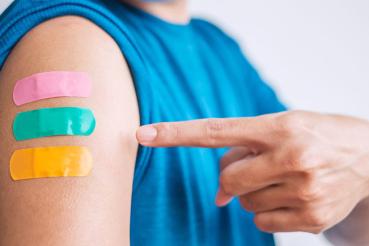From Chicago to Washington, D.C., health experts are endorsing trick-or-treating this Halloween, one year after widespread COVID-19 led many communities to cancel or limit the annual tradition.
Vaccines have greatly reduced the number of COVID-19 cases in places like Chicago with high vaccination rates. Still, the virus continues to spread, particularly among the unvaccinated — including children under age 12.
Rush pediatric disease specialists say families will need to take measures to protect themselves and others this Halloween. That means following standard precautions and finding creative ways to celebrate that will limit the spread of COVID-19 and other viruses like the flu.
One advantage of trick-or-treating is that it's outdoors, allowing for plenty of fresh air. Even so, groups of children and adults gathering and visiting multiple households provides an opportunity to share more than candy.
Colleen Nash, MD, MPH, says parents should help their children follow these important steps:
- Wear a protective mask that covers from the nose to the chin and doesn’t gap on the sides.
- Keep hands clean. Carry hand sanitizer with you and have everyone use it between stops.
- Stay in small groups and don’t congregate in one place.
- Social distance. Give the other trick-or-treaters space to go get their goodies and leave them room to pass by.
“Last year, people got very creative, with some homes setting up candy chutes to drop treats from a safe distance, and others laid out goody bags that were easy to grab without kids having to crowd together,” says Nash, an assistant professor of pediatrics at Rush Medical College. “These strategies with built-in distancing let neighbors share treats without direct contact and without having 100 hands reaching into a single candy bowl.”
Nash offers this additional advice to keep COVID-19 at bay:
- Hold off on hosting or attending large parties or indoor gatherings.
- Get everyone in your household age 12 and older vaccinated against COVID-19 and the flu.
- Watch for COVID-19 symptoms. Anyone with symptoms or who is feeling ill should stay home.
Why COVID-19 remains a threat, especially to children
While the pandemic is subsiding in the Chicago area and much of the nation, now is not the time to let down our guard, especially with children, says Latania Logan, MD, MSPH, hospital epidemiologist and chief of pediatric infectious diseases at the Medical Center.
What’s different this year is how the virus is affecting children. While patients under age 18 accounted for only 3% of COVID-19 cases at the start of the pandemic, they make up a much greater share now: 1 in 4 patients is a child. The reason for that increase is twofold, Logan says.
“In the beginning of the pandemic, we were keeping everyone home, and the only people going out were essential workers,” she says. Then after the vaccines became available, people started to resume their normal activities.
“The world opened up, and children started going to see Grandma, going on playdates, playing sports, and now they are back at school,” Logan says. “It all adds up to more interactions and more exposure to the virus.”
Second, for the past several months, the Delta variant has been circulating, and it now accounts for nearly all COVID-19 cases in the Chicago area and across the nation.
“We know the delta variant is more transmissible,” Logan says. “It’s infecting more people, and it’s infecting primarily people who are unvaccinated, and children under 12 are the biggest group among the unvaccinated.”
While children generally have less severe cases, currently more pediatric COVID-19 patients are needing to be hospitalized, she says. They can become seriously ill, and some may die. Even children with few or no symptoms may develop lingering effects, such as the condition called “long COVID,” or they may suffer from the rare but serious multisystem inflammatory syndrome in children (MIS-C), Logan adds.
Looking ahead to the holidays
But there is hope ahead. Last fall, the number of COVID-19 cases in the Chicago area was spiking. Now, with about 66% of eligible Cook County residents fully vaccinated, COVID-19 cases have fallen to a fraction of their high point, according to data from the federal Centers for Disease Control and Prevention.
And Pfizer Inc. and BioNTech SE have asked the U.S. Food and Drug Administration to review their data on the safety and effectiveness of using their COVID-19 vaccine to protect children ages 5 to 11. If the FDA decides to issue an emergency use authorization later this month, and the CDC then agrees to its use, a vaccine for children may be available by early November.
“If approved, the vaccine would not be distributed in time to protect children on Halloween,” Logan says. “But about 28 million children, a huge portion of the nation, could be protected in time for the winter holidays.”
Logan is looking forward to seeing the younger children getting the vaccine. “If we can get them vaccinated, we can protect them from transmitting to each other and to younger unvaccinated kids and adults who are at higher risk,” she said. “Those are all good things.”




